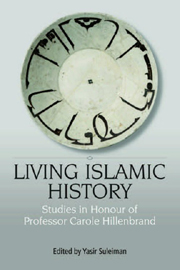Book contents
- Frontmatter
- Contents
- Acknowledgements
- Professor Carole Hillenbrand: List of Publications
- Preface
- 1 The Origin of Key Shi‘ite Thought Patterns in Islamic History
- 2 Additions to The New Islamic Dynasties
- 3 Al-Tha‘alibi's Adab al-muluk, a Local Mirror for Princes
- 4 Religious Identity, Dissimulation and Assimilation: the Ismaili Experience
- 5 Saladin's Pious Foundations in Damascus: Some New Hypotheses
- 6 The Coming of Islam to Bukhara
- 7 A Barmecide Feast: the Downfall of the Barmakids in Popular Imagination
- 8 The History of the Patriarchs of the Egyptian Church as a Source for the History of the Seljuks of Anatolia
- 9 Genealogy and Exemplary Rulership in the Tarikh-i Chingiz Khan
- 10 Vikings and Rus in Arabic Sources
- 11 Qashani and Rashid al-Din on the Seljuqs of Iran
- 12 Exile and Return: Diasporas of the Secular and Sacred Mind
- 13 Clerical Perceptions of Sufi Practices in Late Seventeenth-Century Persia, II: Al-Hurr al-‘Amili (d. 1693) and the Debate on the Permissibility of Ghina
- 14 On Sunni Sectarianism
- 15 The Violence of the Abbasid Revolution
- 16 Nationalist Poetry, Conflict and Meta-linguistic Discourse
- Bibliography
- List of Contributors
- Index
7 - A Barmecide Feast: the Downfall of the Barmakids in Popular Imagination
Published online by Cambridge University Press: 12 September 2012
- Frontmatter
- Contents
- Acknowledgements
- Professor Carole Hillenbrand: List of Publications
- Preface
- 1 The Origin of Key Shi‘ite Thought Patterns in Islamic History
- 2 Additions to The New Islamic Dynasties
- 3 Al-Tha‘alibi's Adab al-muluk, a Local Mirror for Princes
- 4 Religious Identity, Dissimulation and Assimilation: the Ismaili Experience
- 5 Saladin's Pious Foundations in Damascus: Some New Hypotheses
- 6 The Coming of Islam to Bukhara
- 7 A Barmecide Feast: the Downfall of the Barmakids in Popular Imagination
- 8 The History of the Patriarchs of the Egyptian Church as a Source for the History of the Seljuks of Anatolia
- 9 Genealogy and Exemplary Rulership in the Tarikh-i Chingiz Khan
- 10 Vikings and Rus in Arabic Sources
- 11 Qashani and Rashid al-Din on the Seljuqs of Iran
- 12 Exile and Return: Diasporas of the Secular and Sacred Mind
- 13 Clerical Perceptions of Sufi Practices in Late Seventeenth-Century Persia, II: Al-Hurr al-‘Amili (d. 1693) and the Debate on the Permissibility of Ghina
- 14 On Sunni Sectarianism
- 15 The Violence of the Abbasid Revolution
- 16 Nationalist Poetry, Conflict and Meta-linguistic Discourse
- Bibliography
- List of Contributors
- Index
Summary
The Abbasid caliph Harun al-Rashid and his entourage have always had a strong appeal to the imagination. Accordingly, they figure in a wide range of literature, ranging from scholarly history, such as Tabari's Tarikh al-rusul wa'l-muluk, to popular storytelling. The caliph himself, his executioner Masrur, the poet Abu Nuwas and Jafar al-Barmaki are the subject of many a tale in the Thousand and One Nights. Apart from that, a special genre of trickster-like anecdotes has sprung up featuring Abu Nuwas. The Barmakid family, too, has taken up a role in popular tales, where ample attention is usually paid to the history of their dramatic downfall. Extensive work has already been done in this field, most recently by Sadan (1998) and Abouel-Lail (2007), and it is not my intention here to give an exhaustive overview of all the material. My aim here is to analyse how the account of the Barmakids' downfall as depicted in one particular branch of popular literature, namely that of popular epic (sira sha ‘biyya), is related to other parts of the literary tradition.
The downfall of the Barmakids, which took place in January 803, is often referred to in Arabic sources as the nakbat al-Baramika. It has never ceased to stir the imagination of historians as well as of the wider public. What could have incited the Abbasid caliph Harun al-Rashid to bring down this family, with whom he had such close political and personal ties, in such a sudden and utterly ruthless way? Speculation started almost immediately, and found its way into a variety of Arabic and Persian sources.
- Type
- Chapter
- Information
- Living Islamic HistoryStudies in Honour of Professor Carole Hillenbrand, pp. 92 - 106Publisher: Edinburgh University PressPrint publication year: 2010



